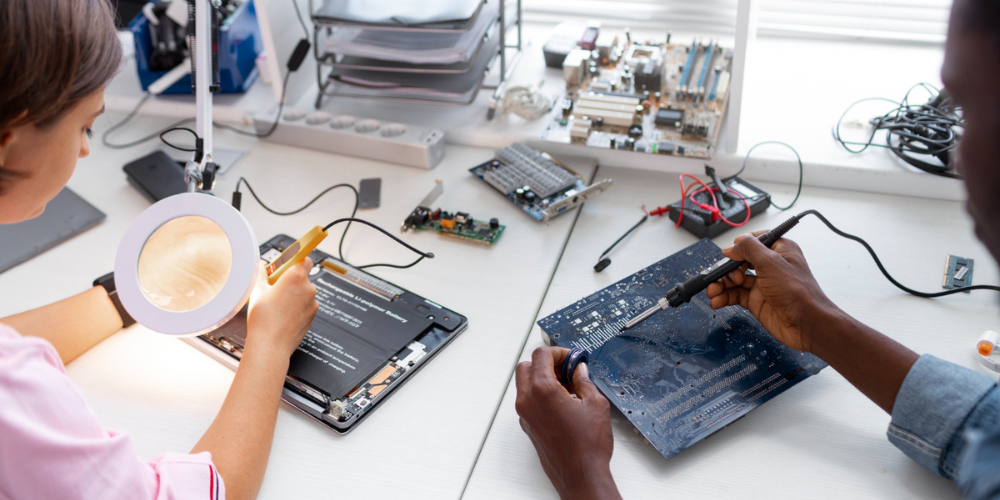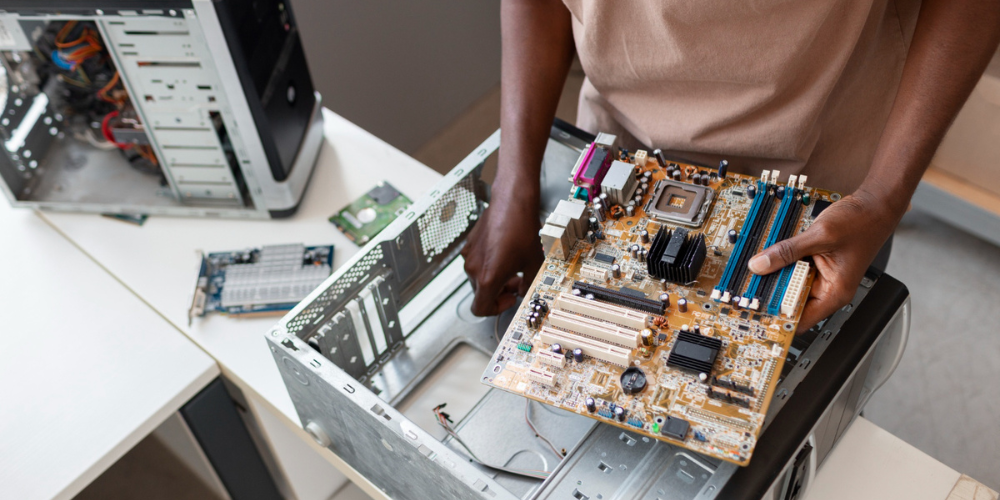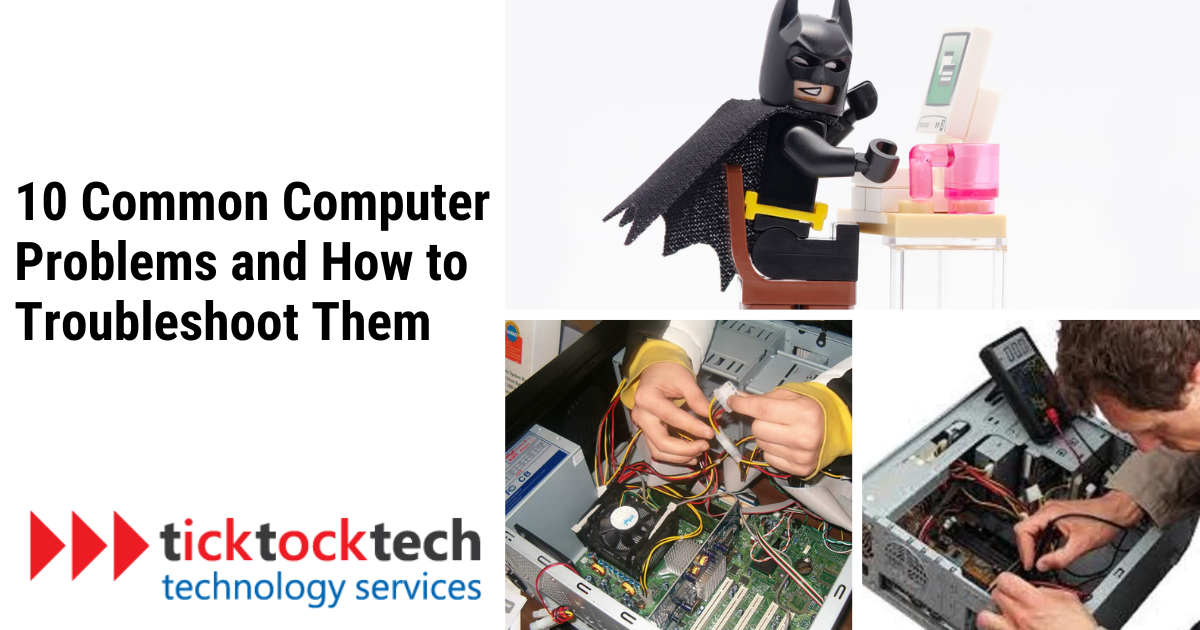While the business IT support team can handle complex computer problems at work, personal computers often encounter common problems that can be easily resolved. This guide will examine the most common computer issues and provide strategies for troubleshooting them.
What are the 10 common computer problems?

1. Slow Performance
Slow performance refers to a computer’s decreased speed and responsiveness when executing tasks, opening applications, or browsing the internet. This computer problem is often caused by a nearly full hard drive, insufficient RAM, multiple apps running simultaneously, or malware.
2. Internet Connectivity Issues
Internet connectivity issues refer to the difficulty of connecting to the internet, which may include slow internet speeds or inability to access websites. These issues often come from incorrect network settings, malfunctioning routers or modems, and disruptions from the service provider.
3. Blue Screen of Death (BSOD)
The Blue Screen of Death (BSOD) is a critical error that causes a computer to crash, displaying a blue screen with error codes. BSODs are often caused by hardware conflicts, driver incompatibilities, or corrupt system files. Hardware issues like failing memory or overheating components can also trigger these errors.
4. Missing Files or Programs
This occurs when files or programs suddenly disappear from a computer. Accidental deletion, malware activity, problematic software updates, or syncing issues with cloud storage can result in missing files. Hardware issues, such as a failing hard drive, can corrupt or erode data.
5. Overheating
This occurs when a computer’s internal components become excessively hot. Overheating is typically caused by blocked air vents, dust buildup, or failing internal fans. High-intensity processes can also overheat components if cooling isn’t sufficient.
6. Unexpected Shutdowns
Unexpected shutdowns refer to instances when a computer turns off abruptly without warning. This issue can arise from faulty power supply, excessive heat, or incompatible hardware components.
7. Noisy Hard Drive
A noisy hard drive produces unusual sounds, like clicking, grinding, or humming. Hard drive noises may indicate mechanical wear or damage, while fan noises are usually related to dust accumulation or overheating.
8. Printer Issues
Printer problems include paper jams, connectivity problems, or print quality issues. These issues can arise from incorrect printer configurations, outdated printer drivers, or connectivity issues, like problems with Wi-Fi, Bluetooth, or physical cable connections.
9. No Sound
This occurs when a computer fails to produce any audio through speakers or headphones. Sound issues are due to incorrect settings, corrupt audio drivers, or physical connection problems. Software conflicts can also mute the sound, and sometimes, system updates reset your audio settings without warning.
10. Crashes and Freezes
Computer crashes and freezes refer to instances when a computer becomes unresponsive or unexpectedly restarts. These issues disrupt workflow and can result in data loss. Crashes can result from software conflicts, hardware failures, or system overheating.
What are the 10 basic troubleshooting steps for fixing a computer problem?

1. How to Speed up your Slow Computer
Boosting your computer’s performance doesn’t have to be complicated. Follow these straightforward steps to make your PC run faster.
Clean and Optimize Storage
- Action Steps: Use your computer’s cleanup tools to remove temporary files and uninstall programs you no longer use. This action frees up valuable space and resources, allowing your computer to run more efficiently.
Update and Upgrade
- Action Steps: Regularly update your operating system and applications to fix bugs and improve efficiency. Consider upgrading your RAM or switching to a Solid State Drive (SSD) for a more substantial speed boost.
Maintain System Health
- Action Steps: Conduct regular scans for malware using reliable antivirus software, and monitor your system’s resource usage through the Task Manager to identify and close resource-heavy applications. Adjusting your system’s visual effects settings can also free up processing power for more critical tasks.
2. How to overcome Internet connection problems
Overcoming internet connection problems requires a systematic approach to identify and resolve issues efficiently. Here are three effective strategies:
Check Your Hardware and Connections
- Action Steps: Ensure all cables are securely connected and in good condition. Restart your modem and router by unplugging them for about 30 seconds before plugging them back in. This simple step often resolves temporary connectivity issues by refreshing your network hardware.
Update Network Drivers and Software
- Action Steps: Outdated network drivers can lead to connectivity problems. Check for and install any available updates for your network adapter’s driver through the Device Manager on Windows or System Preferences on Mac. Additionally, ensure your operating system is up-to-date for bug fixes and improved performance.
Optimize Wi-Fi Signal and Settings
- Action Steps: Weak Wi-Fi signals can cause slow or intermittent connections. Move closer to your router or eliminate physical obstructions that may block the signal. Changing your Wi-Fi channel through the router settings to a less congested one can also improve connection quality, especially in densely populated areas.
3. How to fix the Blue Screen of Death
Fixing the Blue Screen of Death (BSOD) may seem complex, but with the right approach, you can resolve it yourself. Here are three effective strategies to tackle this issue:
Perform a System Restore
- Action Steps: Use System Restore to roll back your computer to a previous state before the BSOD issues began. This can reverse any system changes that might have caused the problem, such as driver updates or software installations. Access System Restore by searching for it in the Start menu, choosing a restore point, and following the instructions.
Update or Roll Back Drivers
- Action Steps: Faulty or outdated drivers are common causes of BSOD errors. To update your drivers, visit the manufacturer’s website or use the Device Manager in Windows to check for updates. If the issue started after a recent driver update, consider rolling back to the previous version. Right-click on the problematic driver in Device Manager, select “Properties,” go to the “Driver” tab, and click “Roll Back Driver” if available.
Run System Diagnostics
- Action Steps: Use built-in diagnostic tools to check for hardware issues. Windows Memory Diagnostic can check for RAM problems, while chkdsk (Check Disk) can scan your hard drive for errors. Access Windows Memory Diagnostic by typing it into the Start menu and follow the prompts to start the test. For Check Disk, open Command Prompt as an administrator, type “chkdsk /f“, and press Enter. You may need to restart your computer to begin the scan.
4. How to recover missing files or programs on your Computer
Safeguarding your data is crucial for maintaining productivity. Here are three practical strategies to address this issue:
Use File Recovery Software
- Action Steps: Install a reputable file recovery app to scan your hard drive for recoverable files. These tools can retrieve files that were accidentally deleted or lost due to a system error. Select the drive you wish to scan, follow the software’s instructions, and look through the recoverable files to find your missing data. Always choose software with positive reviews and ensure it’s compatible with your operating system.
Check the Recycle Bin or Trash
- Action Steps: Before using any recovery tools, check your computer’s Recycle Bin (Windows) or Trash (Mac). If you find the missing file there, you can restore it by right-clicking the file and selecting “Restore” or dragging it back to its original location.
Restore from a Backup
- Action Steps: If you regularly back up your computer, check your backup solution, whether it’s an external drive, cloud service, or built-in system feature like Windows File History or macOS Time Machine. Locate the backup containing the missing files or programs and follow the steps provided by your backup solution to restore them. Consistent backups are crucial for data protection and can save time and stress when files go missing.
5. How to stop your computer from overheating
Preventing your computer from overheating is essential for maintaining its performance. Here are three strategies to keep your computer cool and running smoothly:
Ensure Proper Ventilation
- Action Steps: Keep your computer in a well-ventilated area with plenty of airflow around it. Avoid placing it in tight spaces or on soft surfaces like beds and couches, which can block air intake and exhaust ports. Regularly clean the vents and fans with compressed air to remove dust buildup, which can hinder proper cooling.
Upgrade Cooling Systems
- Action Steps: Upgrade your computer’s cooling system. For desktops, this might mean adding or improving case fans, installing a better CPU cooler, or even moving to liquid cooling for more efficient heat dissipation. Laptop users can invest in a cooling pad that helps increase airflow around the device.
Manage Your Computer’s Workload
- Action Steps: Heavy software applications and games can cause your computer to work harder, generating more heat. Monitor your computer’s resource usage through the Task Manager (Windows) or Activity Monitor (Mac) and close unnecessary applications. Adjusting your computer’s power settings to a more energy-efficient option will reduce heat production.
6. How to fix your computer from Shutting down randomly
Fixing a computer that shuts down randomly is crucial for preventing data loss and hardware damage. Here are three targeted strategies to resolve this issue:
Check for Overheating
- Action Steps: Overheating is a common cause of unexpected shutdowns. Ensure your computer’s cooling system is working correctly by checking the fans for operation and cleanliness. Use software tools to monitor temperature levels and identify if overheating triggers the shutdowns. Improve ventilation by cleaning dust from vents and using a cooling pad for laptops.
Update System Drivers and OS
- Action Steps: Outdated drivers and operating systems can lead to instability, like random shutdowns. Regularly check for updates for your system’s drivers, especially the graphics and chipset drivers, and install any pending updates for your operating system. These updates often contain fixes for known bugs that could cause shutdown issues.
Test Your Power Supply
- Action Steps: A failing power supply can cause your computer to turn off unexpectedly. For desktops, use a different power supply if you have one available. For laptops, ensure the battery is properly placed and replace it if it’s old or damaged.
7. How to repair a hard drive making Noise
Addressing a noisy hard drive quickly is essential to ensure longevity. Here are three key strategies to diagnose and repair a noisy hard drive:
Backup Your Data Immediately
- Action Steps: Before attempting any fix, secure your data by backing it up to another storage device or cloud service. A noisy hard drive can be a sign of imminent failure, and backing up ensures you don’t lose important files.
Check for Physical Issues
- Action Steps: Power down your computer and open the case (for desktops). Ensure the hard drive is securely mounted and all the cables are perfectly connected. Sometimes, noise can result from loose parts or vibrations. For laptops, unless you’re experienced with hardware, it’s advisable to seek professional help.
Run Diagnostic Tools
- Action Steps: Use your computer’s built-in tools or third-party applications to perform a disk check. These tools can scan for and attempt to fix errors or bad sectors on your hard drive. On Windows, you can use the Check Disk utility by opening Command Prompt as administrator and typing “chkdsk /f /r“. On Macs, use Disk Utility’s First Aid feature.
8. How to solve printer problems
Here are the top three strategies to troubleshoot common printer issues. Each strategy is actionable and aimed at restoring your printer’s functionality with minimal downtime:
Check Connections and Restart
- Action Steps: Ensure that your printer’s cables are securely connected, or if it’s wireless, that the Wi-Fi is functioning. Sometimes, simply turning the printer and computer off and then on again can resolve the issue. This restart process refreshes the systems and eliminates temporary glitches.
Update or Reinstall Printer Drivers
- Action Steps: Outdated or corrupted printer drivers can cause printing issues. Visit your printer manufacturer’s website to download the latest drivers. If updating doesn’t work, try uninstalling and then reinstalling the printer drivers. This step often fixes communication problems between the printer and your computer.
Clear Print Queue and Check for Paper Jams
- Action Steps: A stuck print job in the queue can halt all printing. Open the print queue, cancel all documents, and try printing again. Also, check for paper jams or any small debris inside the printer. Even a tiny piece of paper stuck inside can prevent it from working. After clearing any blockages, reset your printer according to the manufacturer’s instructions.
9. How to get your sound back on your computer
Restoring sound on your computer can often be achieved with a few easy steps. Here are three easy solutions to bring back your audio:
Check the Volume Controls
- Action Steps: It sounds simple, but start by checking your computer and application volume settings. Ensure that the volume is not muted or turned down too low, both on your device and in any specific applications you’re using. Also, check the external speakers or headphones to ensure they’re perfectly connected and powered on.
Update or Reinstall Sound Drivers
- Action Steps: Outdated or corrupt sound drivers can lead to audio issues. Access the Device Manager on your computer, locate the sound, video, and game controllers section, and update your audio driver by right-clicking on it. If updating doesn’t resolve the issue, try uninstalling the driver, then reboot your computer to reinstall it automatically.
Configure Playback Devices
- Action Steps: Ensure the correct playback device is selected. Right-click the sound icon in your system tray and select “Open Sound settings” or “Playback devices.” Check if the correct device is set as the default. If your desired device isn’t selected or doesn’t appear, right-click in the box and select “Show Disabled Devices” and “Show Disconnected Devices” to enable and select the appropriate device.
10. How to save your computer from crashing and freezing
Keeping your computer active from freezing or crashing is crucial for a smooth computing experience. Here are three key strategies to safeguard your system:
Keep Your System Updated
- Action Steps: Regularly update your operating system and installed applications. Set your system to update automatically where possible, ensuring you’re always running the latest versions.
Monitor and Manage System Resources
- Action Steps: Overloading your PC resources can lead to freezes. Use the Task Manager (Windows) or Activity Monitor (Mac) to keep an eye on your CPU and memory usage. Close unnecessary applications and tabs in your browser to free up resources. Also, upgrade your RAM or switch to an SSD if you consistently max out your system’s capacity.
Run Regular Maintenance Checks
- Action Steps: Perform regular maintenance such as disk cleanup, defragmentation (for HDDs), and scanning for malware. Use built-in tools like Windows Disk Cleanup and Disk Defragmenter, or their equivalents on other operating systems, to keep your system running smoothly. Also, installing and updating a reputable antivirus app will prevent virus-related crashes and freezes.
Frequently Asked Questions about Common Computer Problems
Conclusion: Computer Problems and How to Troubleshoot Them
Regular maintenance and prompt troubleshooting can significantly enhance your computing experience. By following the strategies outlined in this guide, you can effectively resolve common computer problems, saving you time, money, and frustration. Remember to keep your apps updated, perform regular maintenance checks, and back up your data regularly to safeguard against unexpected issues. If you encounter persistent problems or suspect hardware failure, don’t hesitate to seek assistance from a qualified computer technician.

